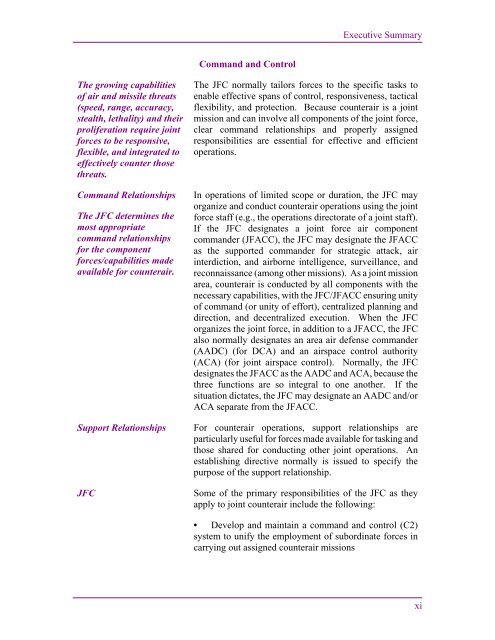JP 3-01 Countering Air and Missile Threats - Defense Innovation ...
JP 3-01 Countering Air and Missile Threats - Defense Innovation ...
JP 3-01 Countering Air and Missile Threats - Defense Innovation ...
Create successful ePaper yourself
Turn your PDF publications into a flip-book with our unique Google optimized e-Paper software.
Executive Summary<br />
Comm<strong>and</strong> <strong>and</strong> Control<br />
The growing capabilities<br />
of air <strong>and</strong> missile threats<br />
(speed, range, accuracy,<br />
stealth, lethality) <strong>and</strong> their<br />
proliferation require joint<br />
forces to be responsive,<br />
flexible, <strong>and</strong> integrated to<br />
effectively counter those<br />
threats.<br />
Comm<strong>and</strong> Relationships<br />
The JFC determines the<br />
most appropriate<br />
comm<strong>and</strong> relationships<br />
for the component<br />
forces/capabilities made<br />
available for counterair.<br />
Support Relationships<br />
JFC<br />
The JFC normally tailors forces to the specific tasks to<br />
enable effective spans of control, responsiveness, tactical<br />
flexibility, <strong>and</strong> protection. Because counterair is a joint<br />
mission <strong>and</strong> can involve all components of the joint force,<br />
clear comm<strong>and</strong> relationships <strong>and</strong> properly assigned<br />
responsibilities are essential for effective <strong>and</strong> efficient<br />
operations.<br />
In operations of limited scope or duration, the JFC may<br />
organize <strong>and</strong> conduct counterair operations using the joint<br />
force staff (e.g., the operations directorate of a joint staff).<br />
If the JFC designates a joint force air component<br />
comm<strong>and</strong>er (JFACC), the JFC may designate the JFACC<br />
as the supported comm<strong>and</strong>er for strategic attack, air<br />
interdiction, <strong>and</strong> airborne intelligence, surveillance, <strong>and</strong><br />
reconnaissance (among other missions). As a joint mission<br />
area, counterair is conducted by all components with the<br />
necessary capabilities, with the JFC/JFACC ensuring unity<br />
of comm<strong>and</strong> (or unity of effort), centralized planning <strong>and</strong><br />
direction, <strong>and</strong> decentralized execution. When the JFC<br />
organizes the joint force, in addition to a JFACC, the JFC<br />
also normally designates an area air defense comm<strong>and</strong>er<br />
(AADC) (for DCA) <strong>and</strong> an airspace control authority<br />
(ACA) (for joint airspace control). Normally, the JFC<br />
designates the JFACC as the AADC <strong>and</strong> ACA, because the<br />
three functions are so integral to one another. If the<br />
situation dictates, the JFC may designate an AADC <strong>and</strong>/or<br />
ACA separate from the JFACC.<br />
For counterair operations, support relationships are<br />
particularly useful for forces made available for tasking <strong>and</strong><br />
those shared for conducting other joint operations. An<br />
establishing directive normally is issued to specify the<br />
purpose of the support relationship.<br />
Some of the primary responsibilities of the JFC as they<br />
apply to joint counterair include the following:<br />
• Develop <strong>and</strong> maintain a comm<strong>and</strong> <strong>and</strong> control (C2)<br />
system to unify the employment of subordinate forces in<br />
carrying out assigned counterair missions<br />
xi

















